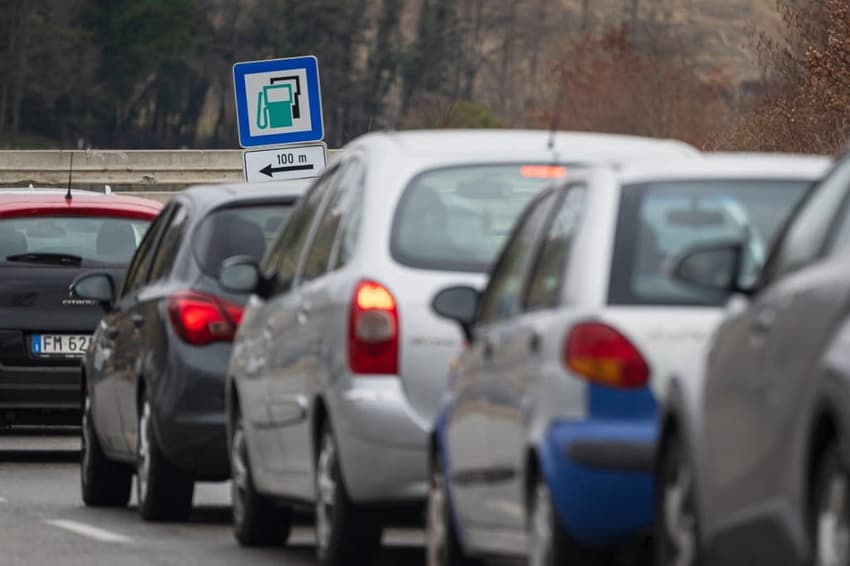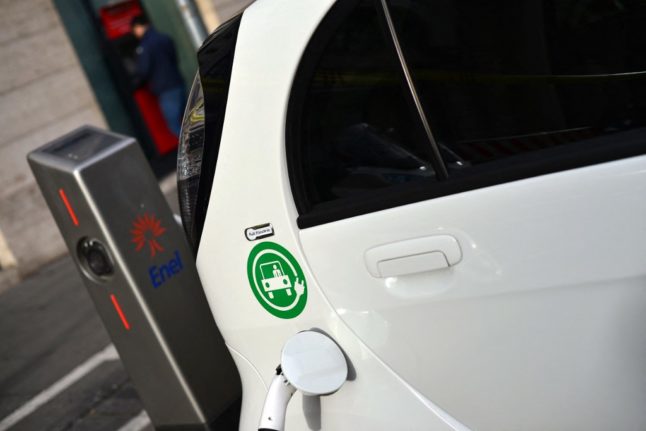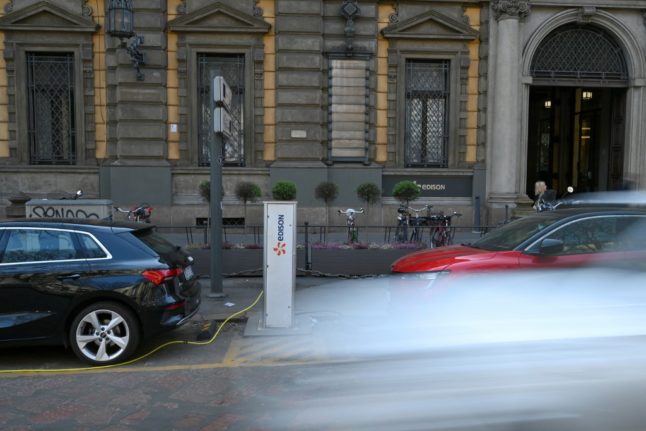Why Italy is fighting EU plans to limit vehicle emissions

Italy's government is leading a revolt against an EU plan for a green car transition, vowing to protect the automotive industry in a country still strongly attached to the combustion engine - despite the impact of climate change.
Prime Minister Giorgia Meloni's hard-right coalition, which came into office last October, tried and failed to block EU plans to ban the sale of new cars running on fossil fuels by 2035, which her predecessor Mario Draghi had supported.
But this week the government took the fight to planned 'Euro 7' standards on pollutants, joining with seven other EU member states - including France and Poland - to demand Brussels scrap limits due to come into force in July 2025.
READ ALSO: Why electric cars aren't more popular in Italy
"Italy is showing the way, our positions are more and more widely shared," claimed Enterprise Minister Adolfo Urso, a fervent proponent of national industry in the face of what he has called an "ideological vision" of climate change.
The EU plan "is clearly wrong and not even useful from an environmental point of view", added Transport Minister Matteo Salvini, leader of the far-right League party, which shares power with Meloni's post-fascist Brothers of Italy.
Salvini led the failed charge against the ban on internal combustion engines, branding it "madness" that would "destroy thousands of jobs for Italian workers" while he claimed it would benefit China, a leader in producing electric vehicles.

Photo by Gabriel BOUYS / AFP
Federico Spadini from Greenpeace Italy lamented that "environmental and climate questions are always relegated to second place", blaming a "strong industrial lobby in Italy" in the automobile and energy sectors.
"None of the governments in recent years have been up to the environmental challenge," he told AFP.
"Unfortunately, Italy is not known in Europe as climate champion. And it's clear that with Meloni's government, the situation has deteriorated," he said.
Low demand
Jobs are a big factor. In 2022, Italy had nearly 270,000 direct or indirect employees in the automotive sector, which accounted for 5.2 percent of GDP.
The European Association of Automotive Suppliers (CLEPA) has warned that switching to all electric cars could lead to more than 60,000 job losses in Italy by 2035 for automobile suppliers alone.
READ ALSO: Italians and their cars are inseparable - will this ever change?
"Since Fiat was absorbed by Stellantis in 2021, Italy no longer has a large automobile industry, but it remains big in terms of components, which are all orientated towards traditional engines," noted Lorenzo Codogno, a former chief economist at the Italian Treasury.
For consumers too, the electric revolution has yet to arrive.
Italy has one of the highest car ownership rates in Europe: ranking fourth behind Liechtenstein, Iceland and Luxembourg with 670 passenger cars per 1,000 inhabitants, according to the latest Eurostat figures from 2020.
But sales of electric cars fell by 26.9 percent in 2022, to just 3.7 percent of the market, against 12.1 percent for the EU average.

Electric cars charge at a hub in central Milan on March 23, 2023. (Photo by GABRIEL BOUYS / AFP)
Subsidies to boost zero emissions vehicles fell flat, while Minister Urso has admitted that on infrastructure, "we are extremely behind".
Italy has just 36,000 electric charging stations, compared to 90,000 for the Netherlands, a country the fraction of the size of Italy, he revealed.
READ ALSO: These are the most (and least) eco-friendly towns in Italy
"There is no enthusiasm for electric cars in Italy," Felipe Munoz, an analyst with the automotive data company Jato Dynamics, told AFP.
"The offer is meagre, with just one model manufactured by national carmaker Fiat."
In addition, "purchasing power is not very high, people cannot afford electric vehicles, which are expensive. So the demand is low, unlike in Nordic countries."
Gerrit Marx, head of the Italian truck manufacturer Iveco, agrees.
"We risk turning into a big Cuba, with very old cars still driving around for years, because a part of the population will not be able to afford an electric model," he said.
Comments
See Also
Prime Minister Giorgia Meloni's hard-right coalition, which came into office last October, tried and failed to block EU plans to ban the sale of new cars running on fossil fuels by 2035, which her predecessor Mario Draghi had supported.
But this week the government took the fight to planned 'Euro 7' standards on pollutants, joining with seven other EU member states - including France and Poland - to demand Brussels scrap limits due to come into force in July 2025.
READ ALSO: Why electric cars aren't more popular in Italy
"Italy is showing the way, our positions are more and more widely shared," claimed Enterprise Minister Adolfo Urso, a fervent proponent of national industry in the face of what he has called an "ideological vision" of climate change.
The EU plan "is clearly wrong and not even useful from an environmental point of view", added Transport Minister Matteo Salvini, leader of the far-right League party, which shares power with Meloni's post-fascist Brothers of Italy.
Salvini led the failed charge against the ban on internal combustion engines, branding it "madness" that would "destroy thousands of jobs for Italian workers" while he claimed it would benefit China, a leader in producing electric vehicles.

Federico Spadini from Greenpeace Italy lamented that "environmental and climate questions are always relegated to second place", blaming a "strong industrial lobby in Italy" in the automobile and energy sectors.
"None of the governments in recent years have been up to the environmental challenge," he told AFP.
"Unfortunately, Italy is not known in Europe as climate champion. And it's clear that with Meloni's government, the situation has deteriorated," he said.
Low demand
Jobs are a big factor. In 2022, Italy had nearly 270,000 direct or indirect employees in the automotive sector, which accounted for 5.2 percent of GDP.
The European Association of Automotive Suppliers (CLEPA) has warned that switching to all electric cars could lead to more than 60,000 job losses in Italy by 2035 for automobile suppliers alone.
READ ALSO: Italians and their cars are inseparable - will this ever change?
"Since Fiat was absorbed by Stellantis in 2021, Italy no longer has a large automobile industry, but it remains big in terms of components, which are all orientated towards traditional engines," noted Lorenzo Codogno, a former chief economist at the Italian Treasury.
For consumers too, the electric revolution has yet to arrive.
Italy has one of the highest car ownership rates in Europe: ranking fourth behind Liechtenstein, Iceland and Luxembourg with 670 passenger cars per 1,000 inhabitants, according to the latest Eurostat figures from 2020.
But sales of electric cars fell by 26.9 percent in 2022, to just 3.7 percent of the market, against 12.1 percent for the EU average.

Subsidies to boost zero emissions vehicles fell flat, while Minister Urso has admitted that on infrastructure, "we are extremely behind".
Italy has just 36,000 electric charging stations, compared to 90,000 for the Netherlands, a country the fraction of the size of Italy, he revealed.
READ ALSO: These are the most (and least) eco-friendly towns in Italy
"There is no enthusiasm for electric cars in Italy," Felipe Munoz, an analyst with the automotive data company Jato Dynamics, told AFP.
"The offer is meagre, with just one model manufactured by national carmaker Fiat."
In addition, "purchasing power is not very high, people cannot afford electric vehicles, which are expensive. So the demand is low, unlike in Nordic countries."
Gerrit Marx, head of the Italian truck manufacturer Iveco, agrees.
"We risk turning into a big Cuba, with very old cars still driving around for years, because a part of the population will not be able to afford an electric model," he said.
Join the conversation in our comments section below. Share your own views and experience and if you have a question or suggestion for our journalists then email us at [email protected].
Please keep comments civil, constructive and on topic – and make sure to read our terms of use before getting involved.
Please log in here to leave a comment.